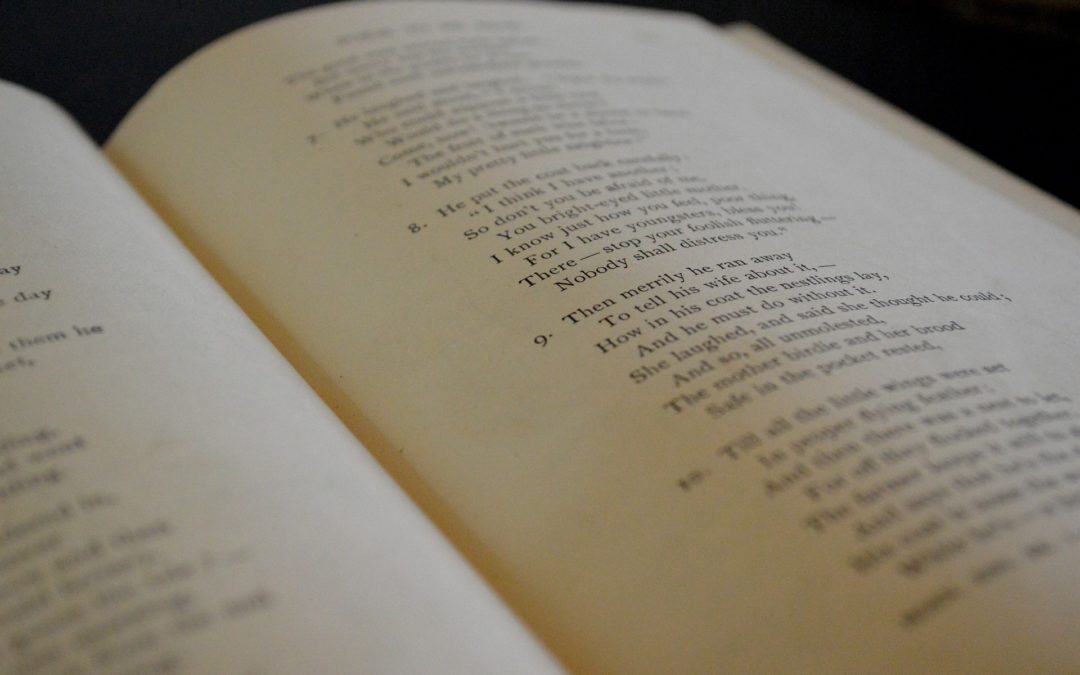When you read a poem, the differences between written prose and poetic language often stand out immediately. The most apparent differences are two of the most basic qualities of poetry: rhyme and meter. We hope to give you an overview of both concepts which are helpful to know when reading a poem.
Rhyme
When we talk about a rhyme, we are referring to the repetition of a final syllable in different words, most often at the ends of lines at certain intervals. Any given poem may fit a rhyme scheme: a rhyme scheme describes the pattern of rhyming sounds within a poem. We will explain this in more detail below. Take Shakespeare’s famous Sonnet 18 for instance. You will notice that it has the typical structure of a Shakespearean sonnet: ABAB CDCD EFEF GG.
Shall I compare thee to a summer’s day?
Thou art more lovely and more temperate.
Rough winds do shake the darling buds of May,
And summer’s lease hath all too short a date.
A
B
A
B
If you look at the final words in each line, you may notice that lines 1 and 3 rhyme perfectly – ‘day’ and May’. The other pair of words in lines 2 and 4 -‘temperate’ and ‘date’- on the other hand, do not appear to rhyme at all. This is due to the fact that there are different types of rhymes, the most common of which we detail below.
Exact rhyme
day/May/fiancé
We have an exact rhyme when the vowels of the final syllable in different words sound the same and the beginning of that final syllable differs. If you look at the transcription of the words ‘day’ and ‘May’ (or even ‘fiancé’), you will notice they exemplify this type of rhyme:
/’deɪ/ /meɪ/ /fiˈɑnseɪ/
Identical rhyme
play/play
An identical rhyme is very similar to an exact rhyme. In fact, both the vowels of the final syllable, as well as the onset of the syllable are identical in the rhyming words. More easily put: the same word rhyming with itself is an identical rhyme.
Slant rhyme
say/rake/mate
When we talk about slant rhymes, we are referring to words which do not rhyme completely. The rhyming words sound similar but not identical. This is especially important due to the existence of English words without rhymes.
Eye rhyme
through/rough/though
This is called an eye rhyme because the words “rhyme” only because of their similar spelling, as the words are pronounced differently. It is interesting to point out that some of these eye rhymes (particularly in older English poems) are a result of historical pronunciation shifts and they used to rhyme phonetically in the past.
Aside from knowing these different types of rhymes, it is also helpful to know that poems often follow rhyme schemes. Rhyme schemes are indicated with letters; the absence of a rhyme is indicated by an x (e.g. A B C A B C – A X A X A A)
Typical rhyme schemes include:
Alternating rhyme: ABAB
Couplet: AA, BB, CC
Enclosed rhyme: ABBA
Limerick: AABBA
Shakespearean sonnet (as seen above): ABAB CDCD EFEF GG
other sonnets: ABBA CDDC EFE FEF
It is helpful to keep in mind that a rhyme and other ‘sound effects’ or structures are rarely accidental and they even carry meaning. The importance of these elements is evident when they are missing; when a poem follows a rhyme scheme and suddenly there is an exception to the pattern, your eye is drawn to it. Using language in such a manner creates an emphasis within the poem.
Meter
Another way to lend structure to a poem is the meter. Meter is the rhythm of the language in the poem; it is described by the number of feet in the poem.
A foot is a part of a poetic line (1-3 syllables) with a certain stress pattern. We have to look at the verse and see which syllables are stressed, and which ones are unstressed. The number of feet in a line give it its name:
A line with one foot: monometer
A line with two feet: dimeter
A line with three feet: trimeter
A line with four feet: tetrameter
A line with five feet: pentameter
A line with six feet: hexameter
A line with seven feet: heptameter
A line with eight feet: octameter
One of the most common meters is the iambic pentameter.
Two-syllable feet:
Iamb
all hours
(Unstressed + Stressed)
Trochee
flow-er
(Stressed + Unstressed)
Spondee
men‘s eyes
(Stressed + Stressed)
Pyrrhic
on their
(Unstressed + Unstressed)
Three-syllable feet:
Anapest
ear-ly light
(Unstressed + Unstressed + Stressed)
Dactyl
white as our
(Stressed + Unstressed + Unstressed)
Amphibrach
Ah feed me
(Unstressed + Stressed + Unstressed)
Amphimacer
Love is best
(Stressed + Unstressed + Stressed)
Bacchius
Some late lark
(Unstressed + Stressed + Unstressed)
Hope this is helpful! Watch this space for exercises applying some of these things to reading one or more of our weekly poems!


